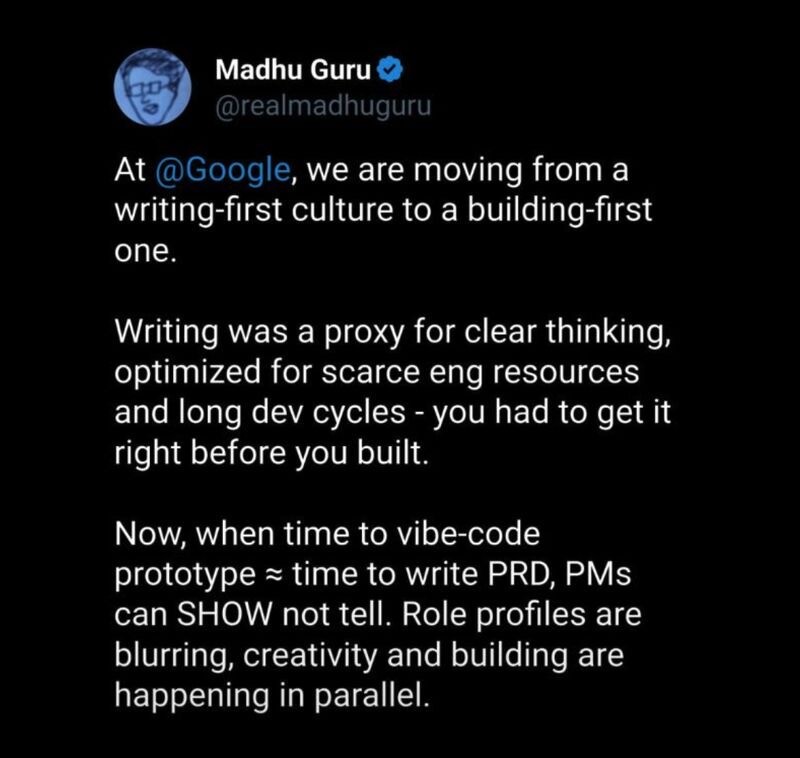






Back to Perspectives
Product development and software engineering are undergoing a profound transformation, driven by the emergence of powerful AI agents that are fundamentally changing how code is written and products are built. This shift is redefining traditional roles, introducing new workflows like “vibe coding,” and demanding a new strategic outlook from the CIO, CTO and CPO. While the battle between AI hype, reality and maturity are being waged on the code generation front, a near term opportunity is opening for AI-Powered Product Development.
The industry is moving away from the traditional model where developers manually write every line of code. The new paradigm is centered on “vibe coding,” a highly iterative and conversational process where a human provides natural language prompts or instructions, and an AI agent generates, refactors, and augments the code. In this paradigm, the primary coding language is English.

The X-post proposes the idea that product managers roles are changing as a result of vibe coding. Specifically, the traditional role that product managers played in the SDLC as authors of product requirements documents (PRD) to communicate needs to software engineers is evolving. AI-powered product managers can build their own prototypes and more effectively communicate requirements in the time it takes to write PRDs.
While this shift is happening today at companies such as Google and AI-native startups, are Enterprises ready for this change?
The adoption of AI in product development is not just a technological change; it is a strategic imperative that requires a coordinated approach from the C-suite. Traditionally, citizen development through low-code / no-code has not always won favor with CIOs and CTOs. The desire from product teams to move faster with technology delivery continues to put pressure on IT departments. An Operational leader recently quipped that “no matter the advances, the IT backlog never goes down”.
Can empowering Product Managers to go from idea to prototype ahead of IT serve as a catalyst for change across the SDLC lifecycle?
The CIO’s focus is on the organizational and operational impact of this new technology. As a champion of AI-powered product development, CIOs can:
The CTO’s focus is on the technological and architectural strategy that will enable this new way of working. Their priorities should be:
The CPO’s focus is on customer and product strategy that will enable this new way of working. In organizations without official CPO roles, Chief Digital Officers, Chief Design Officers and business unit/product heads can be substituted. Their priorities should be:
The adoption of AI fundamentally redefines traditional roles and responsibilities across the product development lifecycle.
| Traditional Roles/Responsibilities | Modern Roles/Responsibilities |
| --- | --- |
| Product Manager: Focused on a detailed product roadmap, acting as a liaison between stakeholders and the development team. | Product Manager: Becomes an expert in prompt engineering to translate customer needs into effective instructions for AI agents. The focus is on rapid prototyping to validate ideas quickly and gather continuous user feedback. PRDs can also be generated and iterated more effectively with AI agents. |
| Software Engineer: Primarily responsible for writing and maintaining code. | Software Engineer: The role evolves into a “code reviewer” and “AI workflow designer.” They are responsible for guiding AI agents, ensuring the generated code is secure and efficient, and building the high-level architecture that the AI will support. |
| Separate QA Team: Manually tests the final product at the end of the development cycle. | Integrated QA: The responsibility for quality is distributed throughout the team. AI agents are used to automatically generate test cases and perform continuous testing, while humans focus on designing the overall testing strategy and conducting high-level exploratory testing. |
The question remains: are Enterprises ready for this transformation? The answer lies not in the technology itself, but in the organization’s willingness to embrace new ways of working.
Cultural Transformation: Successful adoption requires a fundamental shift in how organizations view the relationship between business and technology teams. The traditional handoff model must evolve into a collaborative partnership where product managers are empowered with technical capabilities, and engineers focus on architecting scalable solutions rather than writing every line of code.
Measured Implementation: Enterprises should approach this transformation through pilot programs and controlled experiments. Start with non-critical projects, establish governance frameworks, and build confidence through demonstrable wins before scaling across the organization.
Investment in Learning: Organizations must invest in upskilling their workforce, focusing on AI literacy, hands-on usage, and the soft skills needed to work effectively in human-AI collaborative environments. This is not just about learning new tools—it’s about developing new ways of thinking and problem-solving which can lead to new ways of working and product designs.
The emergence of AI-powered product development represents a once-in-a-generation opportunity to fundamentally reimagine how enterprises build products. The organizations that successfully navigate this transition will gain significant competitive advantages through faster time-to-market, improved customer satisfaction, and more innovative solutions.
However, success requires more than just adopting new tools. It demands a coordinated strategic response from the C-suite, a willingness to challenge established processes, and a commitment to continuous learning and adaptation.
The future of product development is not about humans versus AI—it’s about humans working with AI to achieve outcomes that neither could accomplish alone. Enterprises that embrace this collaborative future today will be the market leaders of tomorrow.
Our recommendation to Enterprises is to not solely focus on AI-generated coding for IT (software engineering, etc.), but to simultaneously empower business Product Managers with the AI-powered tools to accelerate product development, thereby triggering a broader business-driven optimization of the PDLC and SLDC.
Lovable, Bolt, Replit and v0 are popular and leading AI tools to generate front-end applications through “vibe coding” and prompting.
Figma – an already popular design tool – introduced “Figma Make” for AI-powered designs. Enterprise design teams already use Figma and can test the new feature to get started with “vibe coding”.
Google Stitch – a lab experiment from Google uses prompting to create web and mobile front-end designs. As a lab product, it is currently free to use.
Recent Posts


We help organizations reduce inefficiencies, automate workflows, and unlock growth opportunities.

4030 Old Milton Parkway Alpharetta, GA 30005 USA

social@reknew.ai
.svg)
+1(678) 253-2599
© 2025 ReKnew. All Rights Reserved.
